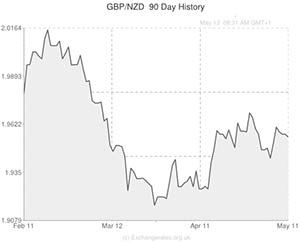
In a quiet news day the Pound was holding steady against the New Zealand Dollar having posted a modest gain against its South Pacific rival overnight.
Last week Sterling was buoyed by upbeat UK service and manufacturing sector reports. The impressive domestic data added to the case for the Bank of England reconsidering its policy stance in the near future and left the Pound stronger against the majority of its currency counterparts.
While the ‘Kiwi’ held its own against the Pound for much of the week, New Zealand’s currency did come under pressure as officials stressed the adverse impact of a strong local Dollar and intimated that intervention in the currency market could occur.
That being said, the New Zealand Dollar did advance against the US Dollar and a broadly softer Euro on Monday – despite less-than-impressive domestic housing figures.
During the local session New Zealand’s REINZ house price index showed a 0.1 per cent month-on-month gain in April, considerably smaller than the 3.4 per cent advance recorded the previous month.
REINZ house dales dropped by 20.2 per cent in April year-on-year, up from an annual decline of 10.0 per cent in March.
According to the Real Estate Institute of New Zealand, the steep drop in sales volumes was largely the result of the Reserve Bank of New Zealand’s restrictions on low deposit lending and the central bank’s increasing of interest rates.
The GBP to NZD pairing remained slightly stronger as investors focused on this week’s UK employment data.
If the UK’s unemployment rate declines to 6.8 per cent in the three months to March, as expected by economists, the Pound could push higher against its peers.
The Pound was also supported by the news that Lloyds employment confidence measure advanced from -2 in March to 1 in April.
Over the next week the following economic reports for New Zealand will be of particular interest; Food prices, retail sales excluding inflation, non resident bond holdings and business performance of manufacturing index.
New Zealand’s retail sales increased by 3.9 per cent quarter-on-quarter in the final three months of 2013.
In the view of analysts with ANZ; ‘The high New Zealand Dollar is making imported retail goods attractive, and strengthening housing activity is also lifting demand for consumer durables with the consumer mood also very buoyant.’
As China is one of New Zealand’s major trading partners, the Asian nation’s industrial production, retail sales and business indicator data could have an impact on the ‘Kiwi’s exchange rate.
US advance retail sales and inflation figures will be of additional interest.
As it stands, the Pound to New Zealand Dollar exchange rate is up 0.27 per cent.
New Zealand Dollar (NZD) Exchange Rates
[table width=”100%” colwidth=”50|50|50|50|50″ colalign=”left|left|left|left|left”]
Currency, ,Currency,Rate ,
New Zealand Dollar, ,US Dollar,0.8620,
,US Dollar,0.8620,
New Zealand Dollar, ,Euro,0.6267,
,Euro,0.6267,
New Zealand Dollar, ,Australian Dollar,0.9218,
,Australian Dollar,0.9218,
New Zealand Dollar, ,Pound Sterling,0.5116,
,Pound Sterling,0.5116,
US Dollar, ,New Zealand Dollar,1.1614,
,New Zealand Dollar,1.1614,
Euro, ,New Zealand Dollar,1.5958,
,New Zealand Dollar,1.5958,
Australian Dollar, ,New Zealand Dollar,1.0862,
,New Zealand Dollar,1.0862,
Pound Sterling, ,New Zealand Dollar, 1.9553,
,New Zealand Dollar, 1.9553,
[/table]

Comments are closed.